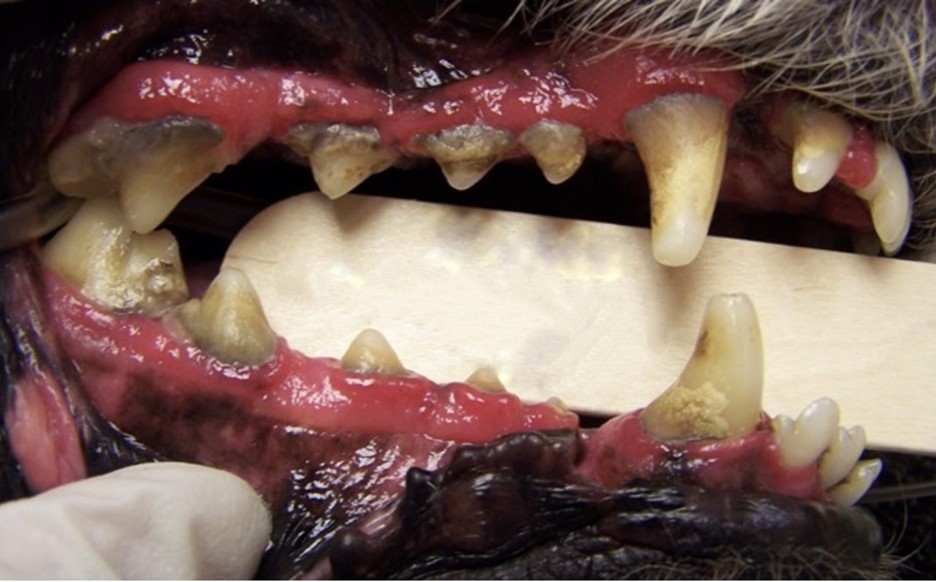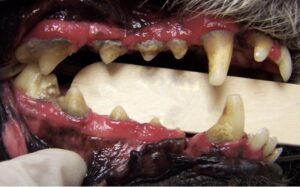
Isn’t it funny that we humans rarely notice our own bad breath? It is clearly obvious that our beloved dogs and cats are the same. Have you ever heard of your doggie’s housemate complain of bad breath or say, ‘go brush before I kiss you’? We humans, on the other hand, do notice when our two-legged and four-legged friends have bad breath. It is quite often offensive.
Bad breath can have significant adverse effects on our relationships. At Carefree Dentistry and Oral Surgery, the doctors are board certified veterinary dentists; therefore, we are responsible for fostering that precious and special human and animal bond. It is our responsibility not to let bad breath adversely affect the relationship between our pets and their humans. Sadly, the author has seen pets be banned from the bed or even the house due to horrible bad breath.
Bad breath is better termed “halitosis.” Halitosis derives from the Latin ‘hallitus’ or breath. The suffix ‘-osis’ denotes a pathological (abnormal or diseased) state. Frequently, halitosis is a symptom of a pathological state. In other words, halitosis could be the signal that something larger is wrong.
Most often the cause of halitosis is plaque. (The exceptions would be a dental infection, abscessation, oral tumor, or mass; systemic illness such as kidney or gastrointestinal disease can also cause an abnormal odor to the breath) Plaque is a film of bacteria that forms on the surface of the mouth, especially the teeth. Plaque is sometimes described as the goopy film present on the surfaces of one’s teeth when waking in the mornings. As expected, it is the cause of stinky “morning breath.”
The bacterial species involved in plaque produce volatile sulphur compounds (VSCs). The two most common types of VSCs are hydrogen sulfide and methyl mercaptan. Those two compounds have a very offensive odor. Plaque starts to form within minutes of brushing the teeth or even minutes after a professional dental cleaning.
If plaque is not removed from the surface of the teeth, it will start to mineralize within 48 hours. When plaque mineralizes, it is referred to as calculus or tartar. Calculus is a nasty brown, yellow, or green color and is a protective environment for the bacteria that produce VSCs; therefore, it STINKS bad. Calculus cannot be removed by brushing alone. It requires professional dental scaling under general anesthesia.

1. The brown material on the teeth is calculus. Wow, this stinks! Note that the gums are red and inflamed.
Most people consider halitosis to be primarily a cosmetic disorder or nuisance. However, there are numerous publications [1],[2],[3] that document the toxicity of VSCs on oral tissues, even at low levels. VSCs can cause periodontitis. The periodontium is the supporting tissue of the teeth. Periodontitis is inflammation of the periodontium. It is also known as periodontal disease.
Periodontal disease can lead to pain, suffering, tooth loss, and systemic illness. The treatment of halitosis should not be considered a simple cosmetic procedure because it has been shown that the VSCs of halitosis have a detrimental effect on oral tissues, and play a role in the initiation and progression of painful periodontal disease.
Even with the absence of visible plaque and calculus the presence of halitosis indicates that a comprehensive oral health assessment and treatment (COHAT) is needed because halitosis is often the first indication of a serious disease process occurring in the doggies’ or kitties’ mouths.[4],[5] Other studies have directly correlated the degree of VSCs (how bad the breath is) with the degree of periodontal disease.2
Although subjective, most board certified veterinary dentists see a direct correlation with the degree of periodontal disease based upon the degree of halitosis. For example, when one of our specialists enters an exam room and smells a strong VSCs odor, that patient will often have severe periodontal disease.
Studies have shown that a COHAT by a board certified veterinary dentist reduces halitosis for as long as three months.[6],[7] Once the teeth are professionally cleaned, scaled, and polished, it is time to institute home care. Regular home care can greatly reduce the incidence of halitosis, periodontal disease, and hence systemic disease.
The gold standard of home care is brushing the teeth. Although dental chews and rinses can be helpful, no current product is better than brushing. There are limitations to the frequency of brushing. Twice daily brushing is best, once daily is very good. Brushing our pets’ teeth less often than every other day is ineffective. A fair compromise is to brush Fido’s teeth for two minutes every Monday, Wednesday, and Friday…. but more often is better.
Remember that calculus cannot be removed by brushing the teeth. The removal of calculus requires dental scaling and polishing under general anesthesia by a trained human. In addition, brushing the teeth is much more effective after the teeth have been professionally cleaned and polished. Even though your dog gets its teeth brushed daily, they still need to regularly visit their board certified veterinary dentist. It is no different than a human brushing and flossing daily and still having their teeth professional cleaned, polished, and examined every six months.
Even in the face of exemplary home care for humans or animals problems can arise. Those problems are typically much easier to address if detected sooner rather than later. It is a well-known fact that our pets age much faster than humans…up to seven times faster. Therefore, if Fido visits his board certified veterinary dentist once every year, his mouth has aged the human equivalent of up to seven years!
Don’t forget to brush kitty’s teeth too. Cats can be taught to accept brushing, especially when starting as a kitten, being gentle, and having a little luck.
Rinses and toothpaste containing chlorhexidine have been shown to reduce halitosis, as have some dental chews and water additives…again the teeth must start out clean to be effective; therefore, it is best to start brushing after a professional dental cleaning by your board certified veterinary dentist. And again, nothing is as effective as regularly brushing the teeth.
The best place to find a list of safe and effective products to aid in good oral hygiene for our pets is on the website of the Veterinary Oral Health Council (VOHC.org). The VOHC reviews research and clinical trials on products such as dental chews, dental diets, water additives, pet toothpaste, etc. to determine their safety and effectiveness.
In summary, halitosis is NOT just expected and normal for dogs and cats. Stinky breath frequently indicates a more severe oral problem. If your dog or cat suffers from halitosis, or you are suffering from your doggie’s or kitty’s halitosis, we, as veterinary dental specialists can help.
Kipp J. Wingo, DVM
Diplomate, American Veterinary College of Dentistry
Carefree Dentistry & Oral Surgery for Animals
